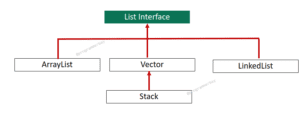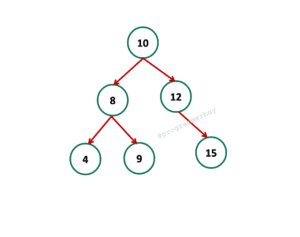Stack extends Vector class that implements Last in first out (LIFO) data structure, introduced in JDK 1.0. The data structure specifies the last element to be added to the stack, is the first one to be removed. It is a subclass of the Vector class that enables it to inherit all the attributes and methods of its parent class. It is considered as a legacy class as it exist even before the collection framework and it is re-engineered to support the collection.

Further, it provides only a default constructor to create an empty stack object.
One of the main use case of the Stack class is to reverse a sequence of elements. This can be done by pushing elements onto the stack and then popping them off one by one from the top.
The collection class provides various methods for manipulating elements present in the stack, such as push(), pop(), peek(), and empty().
Methods Of Stack Class
push(): The push method is used to add an element to the top of the stack
pop(): The pop method is used to remove and return the element at the top.
peek(): The peek method returns the element at the top without removing it.
empty(): It returns true if the stack is empty, otherwise, false.
search(): It searches an element, and returns offset, otherwise, -1 to signify not found.
Other Inherited Methods
| Methods | Explanation |
|---|---|
| addElement(T obj) | Inserts an element to the end of the list. |
| removeElement( T obj) | Removes the very first occurrence of the given element |
| trimToSize() | Reduces the capacity of the given vector to the current size |
| ensureCapacity(int minCapacity) | Increases the capacity to ensure that the list can hold at least the specified number of elements |
| setSize() | Set the size of the given vector, storing null values to new empty spaces |
| capacity() | Returns the current capacity of the vector |
| insertElementAt(T obj, int indx) | Inserts the given element at the specified position, moving elements greater than that index by 1 |
| removeElementAt(int indx) | Deletes the element at the specified index |
| setElementAt(T obj, int indx) | Replaces the element at the specified position with the specified element |
| elementAt(int indx) | Returns the element at the given position |
| firstElement() | Returns the first element in the list |
| lastElement() | Returns the last element in the list |
| copyInto(Object[] o) | Copies elements to the given arrays passed as parameter |
| indexOf(T o) | Returns the index of the first occurrence of the specified element |
| add(T obj) | It inserts an element to the end and returns true if it's added successfully |
| add(int indx, T obj) | It inserts the given element at the specified index of the list |
| addAll(Collection c) | It adds entire compatible collection objects to the end of the list |
| addAll(int indx, Collection c) | It inserts all the compatiable collection objects at the given index in the list |
| clear() | It removes or truncates all the elements from the given list |
| contains(Object obj) | It returns true if the given object is present within the list |
| containsAll(Collection obj) | It returns true if all the elements in the given collection are present in the list |
| equals(Object obj) | It returns true if the given object is equivalent to the list |
| hashCode() | It returns hashcode of a list |
| indexOf(Object c) | It returns the index of the given object which matches first, oterwise -1 is returned |
| isEmpty() | It checks whether a list contains any element or not. |
| iterator() | It returns iterator object for a list |
| lastIndexOf(Object obj) | It returns index of the given object which match first from the last, otherwise, -1 is returned |
| listIterator() | It returns object of ListIterator |
| listIterator(int indx) | It returns listIterator object with the starting point specified with indx. |
| remove(int index) | It removes an element from the specified position and returns the removed object from the list |
| remove(Object obj) | It removes very first occurrence of the given object from the list. |
| removeAll(Collection obj) | It removes all the elements that are present in the given collection from the list |
| replaceAll(UnaryOperator operator) | It replaces all the elements by performing the given operator to them in the list |
| retainAll(Collection c) | It retains all the elements that matches in the given list and removes all others from the list |
| set(int indx, T obj) | It replaces the given object at specified position and returns the replaced object. |
| size() | It returns number of elements present in the list |
| sort(Comparator c) | It sorts the list based on given order specified in the comparator. |
| spliIterator() | It returns SplitIterator object |
| subList(int from, int to) | It returns sublist that falls between fromIndx and toIndex |
| toArray() | t converts and returns an array corresponding to the given list |
Here’s a program example to reverse a sequence of integers using Stack:
Program:
import java.util.Stack;
public class Main
{
public static void main (String[]args)
{
Stack < Integer > stack = new Stack <> ();
stack.push (1);
stack.push (2);
stack.push (3);
stack.push (4);
while (!stack.empty ())
{
System.out.println ("Element :: "+ stack.pop ());
}
}
}Output:
Element :: 4 Element :: 3 Element :: 2 Element :: 1
Over Stack class, the Deque interface should be used as it provides a more complete and flexible API. The Deque interface extends the Queue interface and supports both LIFO and First-In-First-Out (FIFO) operations. The ArrayDeque class implements the Deque interface which is a resizable array and is a good choice for most use cases.
import java.util.ArrayDeque;
public class Main
{
public static void main (String[]args)
{
ArrayDeque < Integer > deque = new ArrayDeque <> ();
deque.push (1);
deque.push (2);
deque.push (3);
deque.push (4);
while (!deque.isEmpty ())
{
System.out.println ("Element :: "+deque.pop ());
}
}
}Element :: 4 Element :: 3 Element :: 2 Element :: 1

